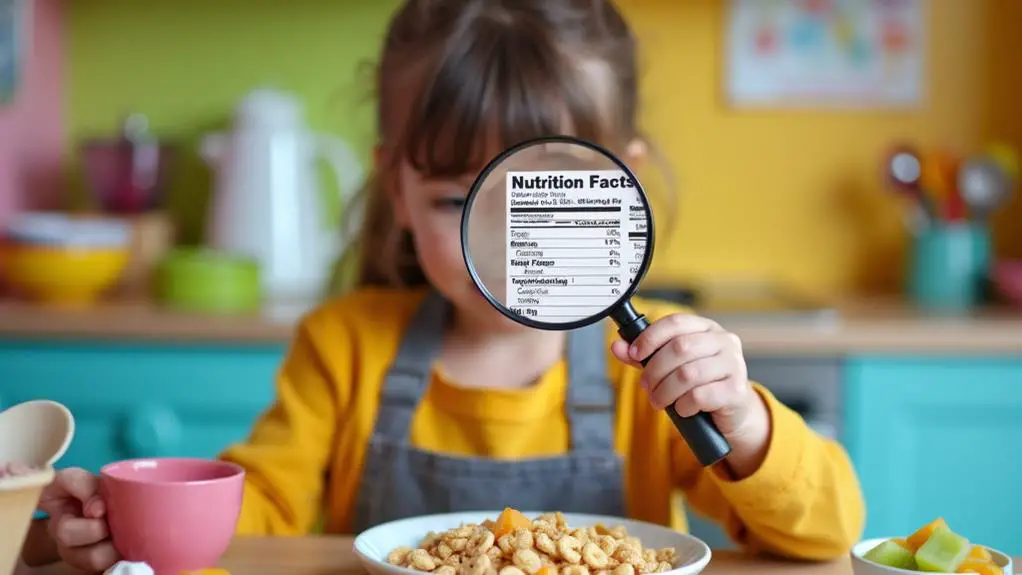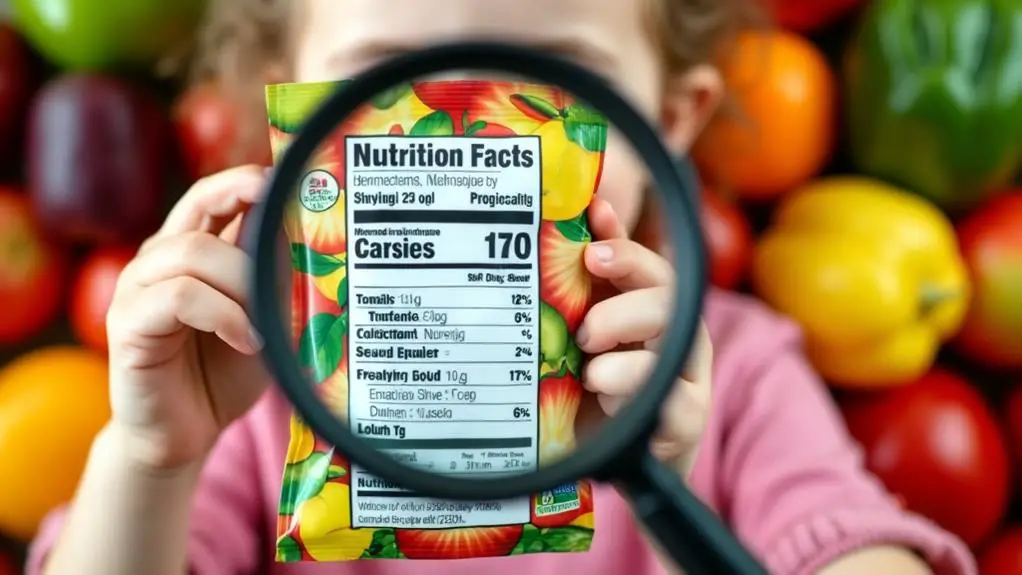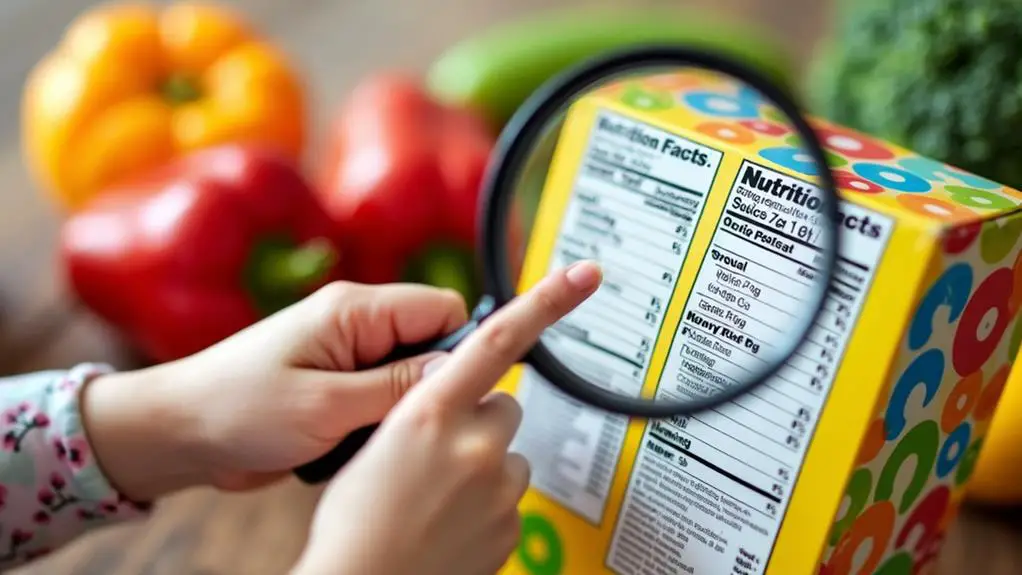Teaching Kids About Reading Nutrition Labels
Teaching kids about nutrition labels empowers them to make healthier food choices. Start by explaining the importance of serving sizes and how they affect calorie intake. Show them how to identify key nutrients like protein, fiber, and vitamins, as well as less desirable elements like added sugars and saturated fats. Encourage them to compare products and look for foods with higher percentages of beneficial nutrients. Make it fun with games and activities, such as scavenger hunts at the grocery store or creating colorful infographics. By understanding nutrition labels, children can develop lifelong healthy eating habits. Discover more ways to make label reading engaging and educational for kids.
Key Takeaways
- Explain serving sizes and their impact on calorie and nutrient intake to help children understand portion control.
- Teach kids to identify core nutrients like fats, carbohydrates, and proteins on labels for informed food choices.
- Introduce the concept of Percentage Daily Value (%DV) to help children gauge nutrient levels in foods.
- Focus on distinguishing between total sugars and added sugars, emphasizing the importance of limiting added sugar intake.
- Use engaging activities like games, scavenger hunts, and infographics to make learning about nutrition labels fun and interactive.
Why Nutrition Labels Matter
Knowledge is power, especially when it comes to nutrition. Teaching kids how to read nutrition labels is an essential step in empowering them to make informed food choices. These labels provide critical information about the nutritional composition of foods, helping children understand what they're putting into their bodies.
By familiarizing kids with nutrition labels, you're equipping them with the tools to identify important nutrients, recognize potentially harmful ingredients, and make smarter decisions about their diet.
Understanding nutrition labels can also help children develop lifelong healthy eating habits. They'll learn to identify serving sizes, balance their meals, and become more aware of their dietary choices.
Decoding the Nutrition Facts Table
When teaching kids about nutrition labels, start with the basics of the Nutrition Facts Table.
You'll want to emphasize the importance of serving size, which affects all the nutrient values listed.
Next, introduce the concept of Percentage Daily Value (%DV) to help kids understand whether a food is high or low in specific nutrients.
Then explain core nutrients like carbohydrates, fats, and proteins in simple terms.
Serving Size Matters
Understanding serving sizes is an essential first step in decoding nutrition labels. When you're teaching kids about nutrition, emphasize that the serving size on the Nutrition Facts Label represents a typical portion. It's important to compare this to what they actually eat, as it affects their caloric intake and nutrient consumption.
Explain that serving sizes vary between products, so they should always check before comparing items. Teach them to look at the number of servings per container, which helps calculate total nutrients when eating the whole package.
Show how serving size relates to the Daily Value percentages listed. Highlight that larger serving sizes often mean higher calorie counts, stressing the significance of portion control.
Percentage Daily Value
After grasping serving sizes, kids can tackle the next key element of nutrition labels: the Percentage Daily Value (% DV). This vital tool helps you quickly assess a food's nutritional value based on a 2,000-calorie diet.
When teaching children about % DV, remember that their caloric needs may differ from adults. Encourage them to use % DV as a guide for making healthy choices.
Here's what to focus on when explaining % DV to kids:
- 5% or less is considered low
- 20% or more is considered high
- Use it to limit intake of saturated fat, added sugars, and sodium
- Look for higher percentages of beneficial nutrients like fiber and vitamins
Core Nutrients Explained
Now that kids grasp serving sizes and % DV, it's time to explore the core nutrients listed on nutrition labels. Food labels provide essential information about total fat, carbohydrates, protein, and vitamins and minerals. When reading these labels, you'll notice that carbohydrates include dietary fiber and total sugars. It's important to distinguish between naturally occurring sugars and added sugars. The ingredient list can help you identify added sugar sources.
| Nutrient | Function | Example |
|---|---|---|
| Protein | Builds muscles | Chicken |
| Fiber | Aids digestion | Oatmeal |
| Vitamins | Support growth | Oranges |
Pay special attention to vitamins and minerals like Vitamin D, calcium, iron, and potassium. Foods providing 10% or more of the daily value for these nutrients are considered good sources. By understanding these core nutrients, you'll make more informed choices about the foods you eat.
Understanding Serving Sizes

Serving sizes often confuse both adults and children alike. When teaching kids about nutrition labels, it's essential to emphasize the importance of understanding serving sizes. Explain that the serving size on a nutrition label represents a standard amount typically consumed, helping them grasp how many calories and nutrients they're getting per portion.
Encourage comparing the listed serving size with what they actually eat to accurately assess their intake.
To make serving sizes more relatable, point out that they're often measured in common household units:
- Cups
- Ounces
- Pieces
- Tablespoons
Teach kids that serving sizes play an important role in portion control. Consuming multiple servings can lead to higher caloric intake than intended.
Identifying Added Sugars
When teaching kids about added sugars, you'll want to show them where to find this information on nutrition labels. Help them distinguish between naturally occurring sugars and added ones, explaining that ingredients are listed by quantity.
It's essential to emphasize the recommended daily limit of 25 grams of added sugars for children, encouraging them to make healthier choices by comparing products.
Locating Added Sugar Information
Understanding how to locate added sugar information on nutrition labels is essential for making informed food choices. To find this vital data, read the Nutrition Facts label carefully. Look for the "Added Sugars" section, which indicates sugars added during processing. A higher percentage here means more empty calories.
When examining ingredient lists, be aware of common names for added sugars:
- Sucrose
- High fructose corn syrup
- Agave nectar
- Corn syrup
To make healthy choices, compare products and opt for those with lower added sugar content, preferably 5% Daily Value or less.
Teaching kids to identify and understand this information empowers them to make better decisions about their diet. Remember, the American Academy of Pediatrics recommends children consume less than 25 grams of added sugar daily for ideal health.
Comparing Natural Vs. Added
Two key types of sugars appear on nutrition labels: natural and added. Natural sugars occur in whole foods like fruits and vegetables, while added sugars are incorporated during processing.
It's essential to teach children the difference between these sugars when reading nutrition labels. Explain that added sugars contribute empty calories without nutritional benefits, unlike the natural sugars found in fruits and dairy products.
When comparing labels, encourage kids to look for products with lower amounts of added sugars, preferably less than 5% of the Daily Value per serving.
Help them understand that the American Academy of Pediatrics recommends consuming less than 25 grams of added sugar daily for better health.
Understanding Daily Sugar Limits
Now that kids can distinguish between natural and added sugars, it's time to focus on daily sugar limits. Teach your children that the American Academy of Pediatrics recommends consuming less than 25 grams of added sugar per day. This limit helps promote better health and prevent obesity-related issues.
Encourage kids to read nutrition labels carefully, identifying the grams of sugar added to products. By understanding these limits, children can make healthier choices when selecting snacks and desserts.
To help kids grasp the concept of daily sugar limits, consider these activities:
- Compare added sugar content in different foods
- Create a daily sugar tracker
- Practice reading nutrition labels together
- Brainstorm low-sugar alternatives for favorite treats
Educating children about the importance of limiting added sugars fosters healthier eating habits and improves their overall nutritional knowledge.
Recognizing Healthy Nutrient Levels

When teaching kids about nutrition labels, it's crucial to help them recognize healthy nutrient levels. When reading a nutrition label, explain that a good source of a nutrient contains 10% or more of the Daily Value (%DV). For ideal health, aim for foods with 20% DV or higher in fiber, vitamin D, calcium, and iron. Conversely, encourage choosing foods with 5% DV or less in saturated fat, added sugars, and sodium.
Help kids distinguish between total sugar and added sugars. Natural sugars in fruits and dairy are different from added sugars in processed foods. Teach them to use this table as a quick reference:
| Nutrient | Aim for | Limit to |
|---|---|---|
| Fiber | ≥20% DV | – |
| Vitamin D | ≥20% DV | – |
| Saturated Fat | – | ≤5% DV |
| Added Sugars | – | ≤5% DV |
Lastly, emphasize the significance of understanding serving sizes for accurate nutrient assessment.
Making Label Reading Fun
Recognizing healthy nutrient levels is just the first step. To help kids understand nutrition labels and engage them in making healthy choices, it's crucial to make label reading fun. Incorporate interactive activities that turn learning into an exciting adventure.
Here are some engaging ways to teach kids about nutrition labels:
- Challenge them with the "Sugar Detectives" game, analyzing labels to compare total and added sugars
- Play "Sugar Land" to identify low-sugar options while having fun
- Create colorful infographics simplifying key label components
- Organize grocery store scavenger hunts to search for specific nutrients
You can also use songs and rhymes like "Should I Eat This or Should I Eat That?" to reinforce healthy snack choices.
Conclusion
You've opened the Pandora's box of nutrition knowledge for your kids. Like Sherlock Holmes decoding clues, they'll scrutinize labels with newfound curiosity. They'll navigate serving sizes like Alice in Wonderland, spotting hidden sugars as if they're finding Waldo. As they learn to balance nutrients, they'll become nutritional Jedis. Keep the journey fun, and you'll raise a generation of label-savvy eaters who'll make informed choices as naturally as breathing.







